Related Research Articles

George Albert Smith was an English stage hypnotist, psychic, magic lantern lecturer, Fellow of the Royal Astronomical Society, inventor and a key member of the loose association of early film pioneers dubbed the Brighton School by French film historian Georges Sadoul. He is best known for his controversial work with Edmund Gurney at the Society for Psychical Research, his short films from 1897 to 1903, which pioneered film editing and close-ups, and his development of the first successful colour film process, Kinemacolor.

As Seen Through a Telescope is a 1900 British short silent comedy film, directed by George Albert Smith, featuring an elderly gentleman getting a glimpse of a woman's ankle through a telescope. The three-shot comedy, according to Michael Brooke of BFI Screenonline, "uses a similar technique to that which G.A. Smith pioneered in Grandma's Reading Glass (1900)," and although, "the editing is unsophisticated, the film does at least show a very early example of how to make use of point-of-view close-ups in the context of a coherent narrative ." "Smith's experiments with editing," Brooke concludes, "were ahead of most contemporary film-makers, and in retrospect it can clearly be seen that he was laying the foundations of film grammar as we now understand it."
Arthur Melbourne Cooper was a British photographer and early filmmaker best known for his pioneering work in stop-motion animation. He produced over three hundred films between 1896 and 1915, of which an estimated 36 were all or in part animated. These include Dreams of Toyland (1908) and according to some sources Dolly’s Toys (1901), as well as Matches: An Appeal, which Dutch independent researcher Tjitte de Vries has claimed may have been the first animated film to be shown in public.

The Kiss in the Tunnel, also known as A Kiss in the Tunnel, is a 1899 film British short silent comedy film, produced and directed by George Albert Smith, showing a couple sharing a brief kiss as their train passes through a tunnel, which is said to mark the beginnings of narrative editing. The film is the first to feature Laura Bayley, Smith's wife.
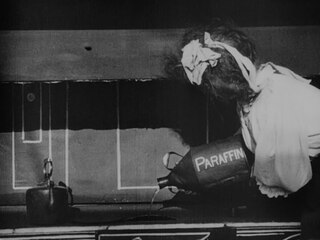
Mary Jane's Mishap; or, Don't Fool with the Paraffin is a 1903 British short silent comedy film, directed by George Albert Smith, depicting disaster following when housemaid Mary Jane uses paraffin to light the kitchen stove. The trick film, according to Michael Brooke of BFI Screenonline, "is an example of Smith's interest in cinematic effects - including, here, the use of superimposition to suggest ghosts," which, "is notable for its then sophisticated mix of wide establishing shots and medium close-ups," and, "also contains two wipes to denote a change of scene."
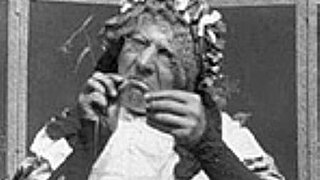
Grandma Threading her Needle is a 1900 British short silent comedy film, directed by George Albert Smith, featuring a grandma trying to get a thread though a needle. The sole purpose of the single-shot film, like the director's earlier Old Man Drinking a Glass of Beer (1898), according to Michael Brooke of BFI Screenonline, "is to record changing facial expressions for the purposes of entertainment."
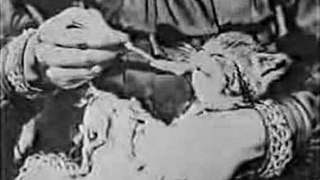
The Sick Kitten is a 1903 British short silent comedy film, directed by George Albert Smith, featuring two young children tending to a sick kitten.
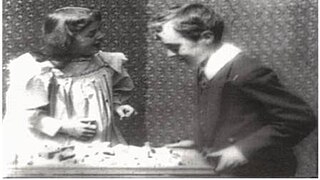
The House That Jack Built is a 1900 British short silent drama film, directed by George Albert Smith, featuring a boy who knocks over a house made of bricks built by his sister and then rebuilds it when the original sequence is shown in reverse. "In addition to exploiting a popular cinematic trick," of, "reversing the film in the projector," and, "its audience's presumed knowledge of the technique," the director, according to Michael Brooke of BFI Screenonline, "was continuing his experiments with narrative forms," with the reversed sequence, "interpreted as wish-fulfilment on the part of the girl, hoping that time will literally turn back on itself to allow her house to be rebuilt," he, "demonstrates that while this is impossible in reality, it is easily achievable in cinema."
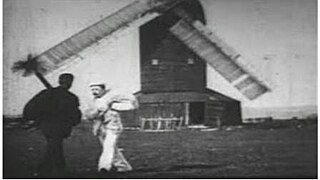
The Miller and the Sweep is a 1898 British short black-and-white silent comedy film, directed by George Albert Smith, featuring a miller carrying a bag of flour fighting with a chimney sweep carrying a bag of soot in front of a windmill, before a crowd comes and chases them away. The film, according to Michael Brooke of BFI Screenonline, "was one of the first films made by G.A. Smith, shortly after he first acquired a camera," and is also, "one of the earliest films to show a clear awareness of its visual impact when projected."
Othello is a 1990 film produced by the Royal Shakespeare Company, starring Ian McKellen, Willard White, Imogen Stubbs, and Zoë Wanamaker. It is based on a stage production of William Shakespeare's play Othello, directed by Trevor Nunn, and later rethought for TV and filmed in a studio. It was shot in a black box theater, so minimal props or scenery were needed, and aired 23 June 1990 on Theatre Night.
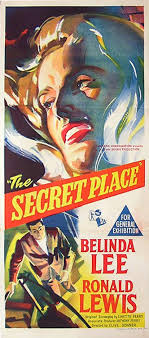
The Secret Place is a 1957 British crime film that was the directorial debut of Clive Donner. It stars Belinda Lee, Ronald Lewis, and David McCallum in a supporting role.

Spiders on a Web is a 1900 British short silent documentary film, directed by George Albert Smith, featuring a single shot close-up of two spiders trapped in an enclosure. The film is, according to Michael Brooke of BFI Screenonline, "less formally ambitious," than the director's, "groundbreaking multiple close-up study Grandma's Reading Glass (1900), made the same year, but is nonetheless, "one of the earliest British examples of close-up natural history photography, predating Percy Smith's insect studies by a decade."

The Old Maid's Valentine is a 1900 British short silent comedy film, directed by George Albert Smith, which features the titular Miss Pimple receiving an unpleasant surprise on 14 February. The film, according to Michael Brooke of BFI Screenonline, "is essentially a facial - a medium close-up shot of a single performer whose changing expression constitutes virtually all the film's dramatic action." David Fisher points out that, "the flapping of the sheet of paper and the movement of the calendar betray the open-air set," which, "makes it difficult to read the message: Just like Mama," whilst, "the remarkably well-behaved cat," which, "sits patently licking its paws," "suggests that Smith may have already learned the trick of smearing the cat's fur with food."

Old Man Drinking a Glass of Beer is a 1897 British short silent comedy film, directed by George Albert Smith, featuring a man drinking a glass of beer whose face and hands become increasingly lively as a result. The single-shot film shows comedian Tom Green, according to Bryony Dixon of BFIfilms, "performing what is known as a 'facial', that is a piece direct to camera showing changing facial expressions. The ability to get close up to the star was a great advantage that film had over the stage and early filmmakers were keen to exploit it."
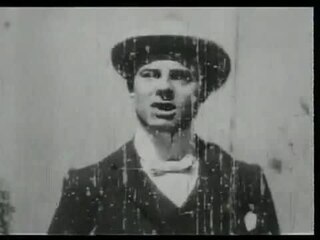
The Big Swallow is a 1901 British short silent comedy film, directed by James Williamson, featuring a man, irritated by the presence of a photographer, who solves his dilemma by swallowing him and his camera whole. The three-shot trick film is, according to Michael Brooke of BFI Screenonline, "one of the most important early British films in that it was one of the first to deliberately exploit the contrast between the eye of the camera and of the audience watching the final film".

Attack on a China Mission is a 1900 British short silent drama film, directed by James Williamson, showing some sailors coming to the rescue of the wife of a missionary killed by Boxers. The four-shot film, according to Michael Brooke of BFI Screenonline, was innovative in content and technique. It incorporated a reverse-angle cut and at least two dozen performers, whereas most dramatic films of the era consisted of single-figure casts and very few shots. Film historian John Barnes claims Attack on a China Mission had "the most fully developed narrative" of any English film up to that time."

Stop Thief! is a 1901 British short silent drama film, directed by James Williamson, showing a tramp getting his comeuppance after stealing some meat from a butcher and his dogs. "One of the first true 'chase' films made not just in Britain but anywhere else", according to Michael Brooke of BFI Screenonline. It was released along with Fire! (1901), "indicating the direction Williamson would take over the next few years, as he refined this new film grammar to tell stories of unprecedented narrative and emotional sophistication."

Let Me Dream Again is a 1900 British short silent drama film, directed by George Albert Smith, featuring a man dreaming about an attractive young woman and then waking up next to his wife. The film stars Smith's real wife, Laura Bayley, as the woman of his fantasies. Bayley would later appear in Smith's 1906 film Mary Jane's Mishap. The film, according to Michael Brooke of BFI Screenonline, "is an excellent example of an early two-shot film, and is particularly interesting for the way it attempts a primitive dissolve by letting the first shot slip out of focus before cutting to the second shot, which starts off out of focus and gradually sharpens." This appears to be the first use of a dissolve transition to signify a movement of a dreaming state to one of reality.

The Cheese Mites (1903) is a British short silent documentary film, produced by Charles Urban and directed by F. Martin Duncan.

Willie's Magic Wand is a 1907 British short silent comedy film, directed by Walter R. Booth, featuring a young boy terrorising the household with his father's magic wand. Similar to "earlier trick films The Haunted Curiosity Shop and Undressing Extraordinary ," this is, according to Michael Brooke of BFI Screenonline, "essentially a series of [loosely linked] special-effects set pieces," however, "the print in the National Film and Television Archive is incomplete, omitting amongst other things a come-uppance where Willie is punished for his misdemeanours by being turned into a girl, thus depriving him of more than one magic wand." A clip from the film is featured in Paul Merton's interactive guide to early British silent comedy How They Laughed on the BFI website.
References
- 1 2 3 Brooke, Michael. "Grandma's Reading Glass". BFI Screenonline Database. Retrieved 24 April 2011.
- ↑ Fisher, David. "Grandma's Reading Glass". Brightonfilm.com. Archived from the original on 22 March 2012. Retrieved 24 April 2011.
- 1 2 Stephen, Bottomore (2002). "Smith Versus Melbourne-Cooper: An End to the Dispute". Film History. 14: 57–73. doi:10.2979/FIL.2002.14.1.57.
- 1 2 3 4 5 Gray, Frank (1999). "Smith versus Melbourne-Cooper: History and Counter-History". Film History. 11: 246–261.
- ↑ Tjitte, de Vries (2000). "Letter to the Editor: The Case for Melbourne-Cooper". Film History. 12: 330–335.